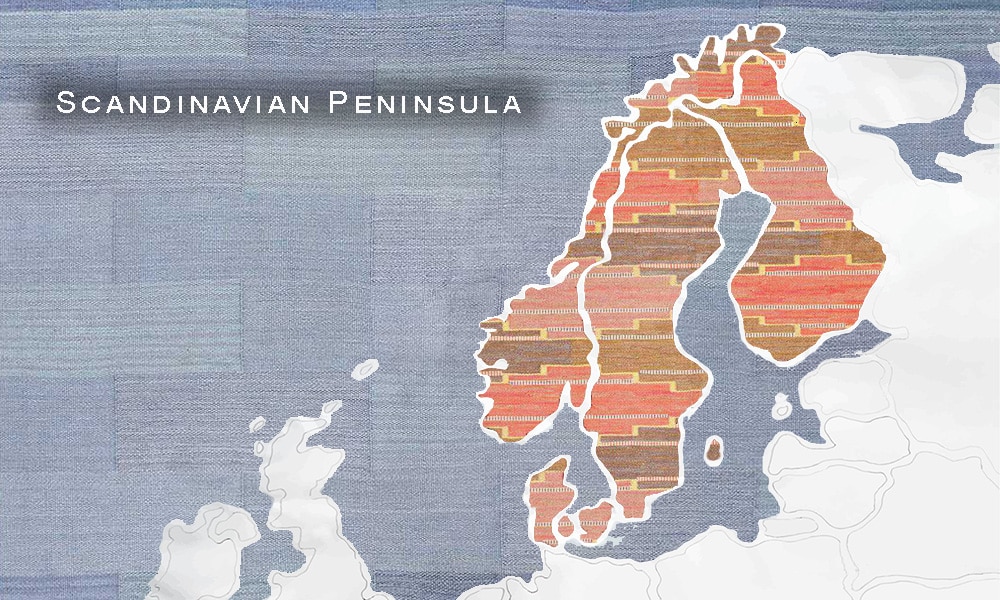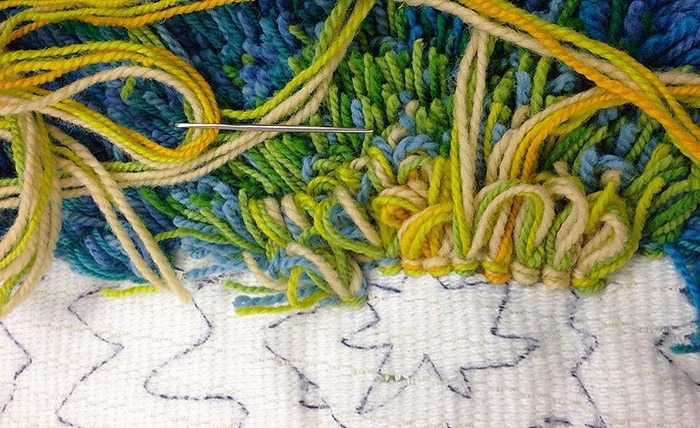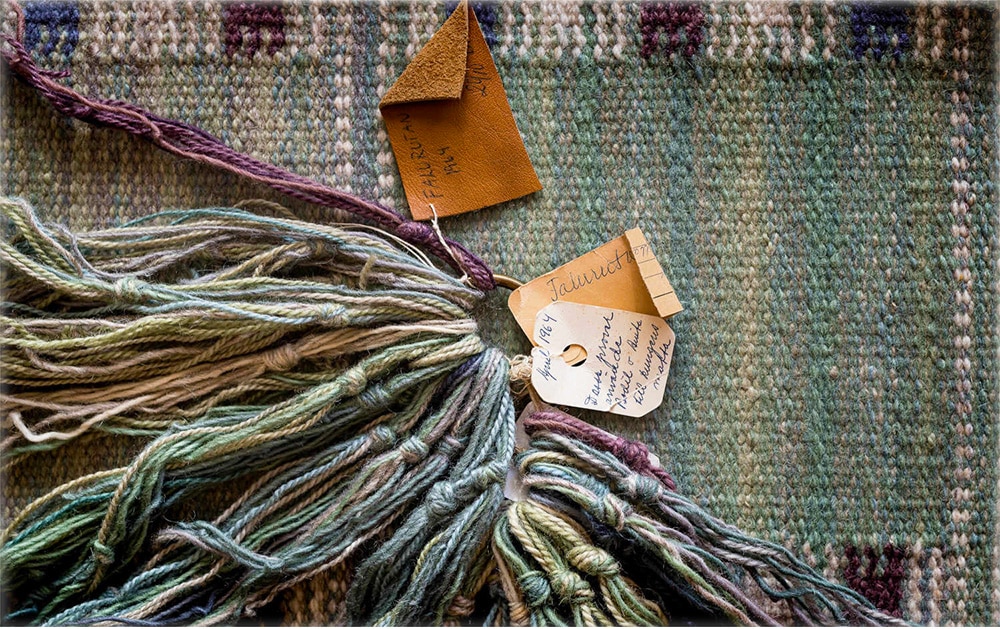Weaving The Swedish Rug: A Short Story About A Long History
Shop Swedish Rugs | Shop Scandinavian Rugs | Shop Vintage Swedish Rya Rugs | Shop All Rugs From Scandinavia | Shop All Vintage Rugs
You May Also Want To Review: Vintage Shag Pile Swedish Rya Rug History | Home Decorating With Scandinavian Area Rugs | 5 Things You Probably Didn’t Know About Vintage Rugs | Choosing Retro Rugs For Your Home Decor | Scandi Home Decor And Scandinavian Interior Design
We all should be considering our area rugs as work of art. But when was the last time you truly appreciated or even thought of the rug weaver who made your rug? Even if you “just” have a special appreciation for interior design you would most definitely think of your rugs and carpets this way. Well, for the Swedish rug weaving industry, not only are their rugs considered works of art, but they’re also a special part of their cultural history.
Swedish Rug Weaving – The Early Years
Unfortunately, there isn’t a lot of solid documentation concerning the early history of rug making in Sweden exclusively. But, if we look at the history of weaving area rugs throughout all of Scandinavia, we can piece together a fairly comprehensive picture of where it all began.

The Swedish Rug
Similar to many textile art forms, such as knitting and weaving, the weaving of Scandinavian rugs began out of necessity more than art. The Scandinavian Peninsula, which is made up of Sweden, Norway, Denmark, and Finland, is in the upper-most part of Northern Europe. As you can imagine, the weather there, especially during the colder months, is not particularly hospitable. Their often frigid temperatures led the Scandinavian peoples to highly value anything that was designed to provide warmth.

Scandinavian Peninsula
This helps to explain why, most likely, they were so quick to pick up rug making. Historians suspect that the inspiration for the earliest Swedish rugs came from Vikings encountering Persian rugs and Turkish rugs and wanting to recreate the insulating effect that the area rugs provided.

Vintage Swedish Rya Rugs and Scandinavian Carpet Viking Ship
It was approximately the mid-12th century when the Scandinavian people began weaving their own versions of this popular textile. They took the concept of the more common kilim rugs and developed their own style of flat-woven rug called “rollakan”. They then took inspiration from the popular Eastern pile rugs and developed the most recognizable Swedish rug, the Swedish Rya rug.

18th Century Dated Swedish Wedding Dowry Rug
Ryas are knotted pile rugs that are made with a special linen backing. The backing is woven in such a way that there are small holes evenly spaced across the material through which woolen yarn can be knotted, creating a piled shaggy rug. When placed shaggy side down, these were found to be incredibly warm bed coverings.

Weaving Shaggy Vintage Swedish Rya Rugs
Both rollakans and ryas were originally made from natural fibers, such as undyed sheep’s wool. This meant that the first Swedish wool rugs contained only earthy colors such as brown, tan, white, and black. Although weavers would sometimes incorporate decorative patterns, the early woven Swedish rug was mainly utilitarian, so solid colors were the most common. Because sheep’s wool is naturally insulating and water-resistant, these early rugs were perfect for seafaring people who would use them as protective cloaks and blankets.

Marta Maas Rug Weavers Weaving A Swedish Rollakan
Eventually, people across the entire peninsula discovered how useful these rugs were, particularly the nobility. By the end of the 14th century, the plain utilitarian Swedish rug had given way to much more decorative versions that included a variety of colors and intricate designs. Little did they know that by adding artistic flair to their area rugs these early Swedish rug weavers were pioneering what would become a long-standing tradition throughout Scandinavia, particularly in Sweden.
Rugs Of Many Colors
The earliest remaining examples of these decorative rugs date back to the early 15th century. They were very high quality and were often treated as family heirlooms. This explains why they were so well-preserved. The most common style of rug found from that era are Rya rugs. Ryas were particularly popular in Sweden and could be found decorating many castle rooms. They remained a decorating favorite until the early 17th century when they finally began to fall out of favor, at least where royalty was concerned.

Swedish Rya Rug Colors
It was during this time that Rya rugs became an important part of the Swedish wedding ceremony. Wealthy families would commission specially designed wedding rugs to be part of their daughters’ dowries. These rugs would usually depict a man and a woman and they would have the year of the wedding woven into the design. The bride and groom would kneel on the dowry rug during the ceremony and then keep it as a memento of their special day. The dowry rug could then be used as a decorative area rug, tapestry or used as a bed covering. This tradition can also be seen in Finland as well as other Scandinavian countries.

Wool Colors For Weaving A Swedish Rug At The Marta Maas Rug Company
By the mid to late 17th century, Swedish rug weaving had developed into a full-fledged art form. The Rya rugs began to include more geometric patterns as well as floral and animal designs. Rollakan rugs also took on a more decorative style, although they were not as popular or artistic as Rya rugs. During the height of their popularity, they were mainly owned by commoners and used both for utility and decoration.
The Rag Rug From Sweden
At this point in the story, a new kind of woven Swedish rug entered the scene, the – rag rug. Nowadays it’s easy for us to think of rag rugs as cute little country decorations. But when they first came into existence, they were more of a status symbol.
In the early 1800’s, when fabric was precious and exclusively made by hand, it wasn’t uncommon for housewives to keep every scrap of fabric they could get their hands on. Old clothes were used and patched until they couldn’t be used anymore and then they were turned into useful things like patches for other clothes. The idea of placing this precious commodity on the floor would have been out of the question.

Swedish Rag Rug
In wealthy households, however, something had to be done with the extra fabric scraps and what better use could there be than rug making? Decorative woven rag rugs started turning up in upper-class homes in the mid-1800’s. Eventually, when fabric became more readily available, middle-class housewives picked up on the trend and a popular art form was born.
Many of the early rag rugs still exist and they provide an interesting peek into the past. They are made out of every clothing material that was available at that time and they reflect the popular color schemes of the day. Most of these rugs contain subtle earthy colors with only a few bright stripes thrown in. This showed that brightly colored clothing was uncommon and cherished, not something to be tossed into the old rag bin.

Pile Of Vintage Swedish Rag Rug
You may be wondering how it is that any of these rag texture19th-century rugs still exist. For that, you need to keep in mind that these rugs were mostly woven by women who knew the worth of the fabric. Not to mention the fact that they knew the amount of work that went into weaving a rug. That is why they would often used these area rug styles only on special occasions such as Sundays and holidays.
Next to Rya rugs, the rag rugs are one of the most iconic pieces of Swedish folk art. Not only can they be found in nearly every chic country home around the world, but they can also be seen depicted in many famous pieces of artwork from the 1800’s. It’s almost like no home was considered complete without one of these classic types of area rugs.
The Modern Swedish Rug Of Today
Many hundreds of years may have passed since the creation of the first Swedish Rya and rollakan rugs. But Swedish rug weavers and textile artists have held tight to this historic textile art form. Throughout the 18th and 19th century, Sweden continued to gain notoriety for the quality and beauty of their area rugs. Not just the fancy Ryas and rollakans, but the humble rag rug as well. By mixing traditional rug-making techniques with new designs, Swedish artists were able to carry this important art form into the 20th and now the 21st century. Nowhere is this more obvious than in the work of the famous Swedish textile artist and designer, Märta Måås-Fjetterström.
The Iconic Marta Maas-Fjetterstrom
Märta Måås-Fjetterström (1873-1941) is one of Sweden’s most, if not the most, well-known Swedish textile artists. Her rugs can be seen decorating royal palaces, on exhibit in museums and even being used in the Nobel Prize ceremony. Marta Maas began designing and making rugs as a young adult. She eventually went one and established her own rug making business in 1919 called Båstad – a business that still exists today. She and her protégé, Barbro Nilsson (1899-1983), had a huge impact on the Swedish rug weaving industry with their innovative weaving techniques and intricate designs. Their complex and colorful tapestries and knotted rugs garnered attention from across the globe, making the handmade rugs from Sweden the envy of home decorators and erudite consumers everywhere.

Portrait Of Märta Måås-Fjetterström
In the 1950’s, the Rya type shag rugs had become so popular that people began wanting to make their own. Swedish textile and rug weaving companies began producing the backing and other materials to sell along with traditional Swedish patterns as kits. These weaving kits would make it so that people around the world could learn the art of Swedish rug making in the comfort of their own homes. Rya rug making continued in popularity until the 1970’s when the cheaper Swedish hooked rug kits became available. In recent years, Rya rugs have regained popularity due to their higher quality and longevity.

Swedish Rug Designer Barbro Nilsson
Up until recently, the vibrant modern designs of artists like Måås-Fjetterström and Niellson had dominated the industry, but nowadays many decorators are looking for a slightly more subtle look. Oddly enough, this has led to a resurgence in the popularity of more traditional Swedish rugs like the flat woven rollakans and the muted rag rugs. This has only increased the desirability of Swedish rugs and they continue to dominate rug markets thanks to their quality and historic beauty.
Swedish Rug Weaving Final Thoughts
Swedish rug weaving has a long and interesting history, not only in Sweden but throughout all of Scandinavia. From simple utilitarian floor coverings to full-fledged status symbols, the Swedish rug has evolved a lot over the years. But even with all the changes, the basic techniques and high-quality craftsmanship remain the same. Knowing this, it’s easy to see why these beautiful rugs are so often sought after and highly cherished. Whether you like the smooth artistic geometric lines of the flat woven rollakan, the shaggy blended look of the Rya, or the uneven textured and rustic look of the rag rug, one thing is for sure, the woven Swedish rug is more than just floor covering. It is a special piece of history and incredible work of art.
This rug blog about “The Swedish Rug” was published by Nazmiyal Antique Rugs in NYC



